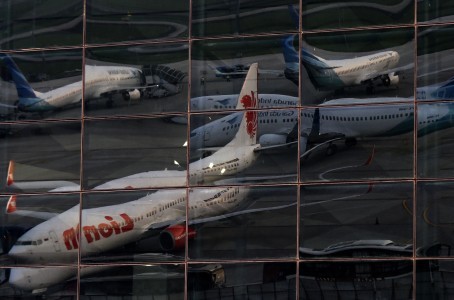Popular Reads
Top Results
Can't find what you're looking for?
View all search resultsPopular Reads
Top Results
Can't find what you're looking for?
View all search resultsRI aviation demand key to recovery in SE Asia: Boeing
Manufacturer to deliver 4,400 aircraft to region by 2039
Change text size
Gift Premium Articles
to Anyone
I
ndonesia will be key to recovering aviation demand in Southeast Asia over the next two decades, according to American aircraft manufacturer Boeing Co., one of the world’s biggest.
Boeing vice president commercial marketing Darren Hulst said the company expected to deliver 4,400 new aircraft to Southeast Asia as the region recovered from the COVID-19 pandemic between 2020 and 2039. Of the figure, a quarter would go to Indonesia.
“Indonesia is by far the largest market in the region and comprises slightly more than a quarter of the 20-year forecast,” Hulst told The Jakarta Post by email on Feb 26.
“The economies in Southeast Asia are not all moving at the same speed. However, the largest population and the most upside potential in terms of growth is definitely the Indonesian market,” he said separately on Thursday, at a virtual briefing on Boeing’s 2020 Commercial Market Outlook (CMO) for Southeast Asia.
Hulst said that single-aisle aircraft made up 81 percent of the projected 4,400 new airplanes, or 3,580 aircraft, followed by 17 percent of wide-body aircraft, or 760 planes. The remaining 2 percent was shared equally between regional jets and freighter aircraft with 30 planes each.
Aircraft manufacturers expect Indonesian demand to grow over the years in line with strong air traffic growth, driven by an expanding middle class and rising domestic flight activity due to the country’s archipelagic geography and, in the context of the COVID-19 pandemic, its loose domestic travel restrictions.
The Boeing CMO projects that Southeast Asia’s overall air travel demand will grow 5.7 percent annually in 2020-2039 to become the second largest aviation market in the Asia Pacific behind China.
Globally, Boeing expects air travel demand to recover to pre-pandemic levels by 2023, driven by short- to medium-haul flights. In comparison, long-haul flights will take longer to recover due to tighter international flight procedures.
The International Air Transport Association (IATA) projects Indonesia’s air passenger market to become the fourth largest globally by 2039, jumping from 10th in 2019, largely thanks to travel demand from the country’s growing middle class.
Read also: Indonesia to have world’s fourth-largest air passenger market by 2039: IAT
Indonesia National Air Carriers Association (INACA) chairman Denon Prawiraatmadja reaffirmed that the country was expected to be a key driver of Asia Pacific aviation demand in the medium to long term. However, recovering Indonesian demand in the short term hinged on containing COVID-19.
“The distribution of vaccines and public health will be the main key to determining the recovery curve,” he told the Post on Thursday.
Indonesia began rolling out its vaccination program on Jan. 13 with President Joko “Jokowi” Widodo being the first to get a jab. The country plans to vaccinate 1.5 million health workers by February, 38.5 million senior citizens by May and 141.3 million other citizens by March 2022.
Denon also pointed out that higher aviation demand might not immediately translate into new aircraft purchases, as airlines also had the more popular and financially sustainable option of leasing planes.
“The aviation business is not just manufacturers and airlines, but also lessors as mediators,” he said.
A case in point is publicly listed Garuda Indonesia. The flag carrier operates 210 aircraft of which 90 percent are under operating leases, according to its third-quarter 2020 financial report. The company owns just 10 percent of the aircraft in its fleet.
Boeing’s optimistic outlook comes after the it reported 18-fold year-on-year (yoy) growth in net losses to US$11,941 million in 2020, compared to $636 million the previous year. It attributed the increased loss to the COVID-19 pandemic devastating appetite for new aircraft and to countries grounding the 737 MAX aircraft following two fatal crashes in 2018 and 2019, the former of which was the Lion Air flight JT610 crash in Indonesia.
The Civil Aviation Directorate General of Indonesia’s Transportation Ministry has grounded the 737 MAX 8 in March 2019 until now.
Read also: Transportation Ministry grounds Boeing 737 MAX 8s in Indonesia
“We’re continuing to work with global regulators and our customers to return the 737 MAX to service worldwide,” said Boeing’s Hulst, adding that the company was improving the aircraft’s software and crew procedures, among other measures.
Australia became the latest country and the first in the Asia Pacific to lift the ban on 737 MAX airplanes on Friday, when Reuters reported that the country would lift a near two-year ban on flights involving 737 MAX planes.
Hulst also said the company expected demand for its 777 aircraft to recover over the medium-to-long term, due to its flexibility in carrying passengers and cargo. Air cargo demand was expected to rise until 2024 and then decline to pre-pandemic levels.
The Boeing 777-200 can carry 317 passengers while the 777-300 can carry 396 passengers, both in a two-class cabin configuration, according to the Boeing website. Meanwhile, the dedicated Boeing 777 Freighter (777F) can carry 102 tons of revenue payload.
Citing IATA data, Hulst said that in 2020 during the pandemic, dedicated freighter capacity increased 29 percent yoy, while the belly capacity of wide-body passenger aircraft dropped 52 percent due to COVID-19 mobility restrictions.
Boeing again came under the spotlight this year after its 777-200 aircraft, powered by Pratt & Whitney PW4000 engines, experienced right engine failure shortly after takeoff from Denver, Colorado.
The company also offers the 777-200 aircraft with two other engine options, the General Electric GE90 and Rolls-Royce Trent 800.
INACA’s Denon said that local airlines followed the Transportation Ministry's decision on the airworthiness of Boeing 777s.
Currently, only Garuda operates the popular Boeing 777 wide-body aircraft in Indonesia, specifically the long-range 777-300ER equipped with GE90 engines.











